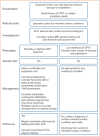Catecholaminergic Polymorphic Ventricular Tachycardia
- PMID: 36644199
- PMCID: PMC9820193
- DOI: 10.15420/aer.2022.09
Catecholaminergic Polymorphic Ventricular Tachycardia
Abstract
Catecholaminergic polymorphic ventricular tachycardia (CPVT) is an inherited arrhythmia syndrome characterised by adenergically mediated bidirectional and/or polymorphic ventricular tachycardia. CPVT is a significant cause of autopsy-negative sudden death in children and adolescents, although it can also affect adults. It is often caused by pathogenic variants in the cardiac ryanodine receptor gene as well as other rarer genes. Early identification and risk stratification is of major importance. β-blockers are the cornerstone of therapy. Sodium channel blockers, specifically flecainide, have an additive role. Left cardiac sympathetic denervation is playing an increasing role in suppression of arrhythmia and symptoms. Concerns have been raised, however, about the efficacy of implantable cardioverter defibrillator therapy and the risk of catecholamine driven proarrhythmic storms. In this review, we summarise the clinical characteristics, genetics, and diagnostic and therapeutic strategies for CPVT and describe recent advances and challenges.
Keywords: catecholaminergic polymorphic ventricular tachycardia; flecainide; left cardiac sympathetic denervation; ryanodine receptor mutation; sudden cardiac death; β-blockers.
Copyright © 2022, Radcliffe Cardiology.
Conflict of interest statement
Disclosure: The authors have no conflicts of interest to declare.
Figures
References
-
- Napolitano C, Bloise R, Monteforte N, Priori SG. Sudden cardiac death and genetic ion channelopathies: long QT, Brugada, short QT, catecholaminergic polymorphic ventricular tachycardia, and idiopathic ventricular fibrillation. Circulation. 2012;125:2027–34. doi: 10.1161/CIRCULATIONAHA.111.055947. - DOI - PubMed
Publication types
LinkOut - more resources
Full Text Sources



